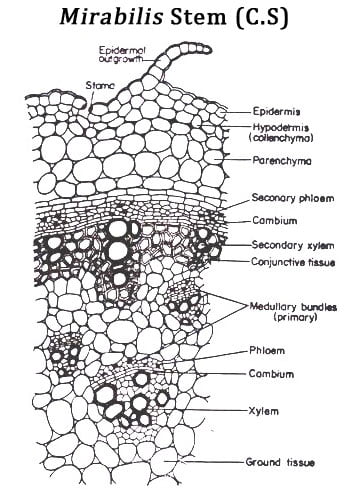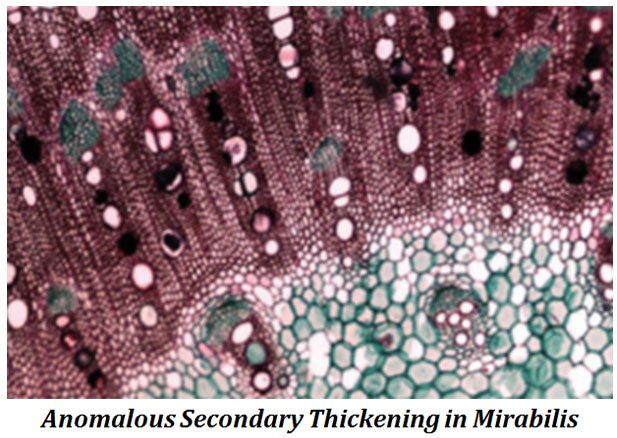Mirabilis jalapa (4 O’clock plant) and Nyctanthes belongs to the family Nyctaginaceae. In the previous post we discussed the anomalous secondary thickening in Amaranthus / Achyranthes (Amaranthaceae). Similar to Amaranthus, the secondary thickening in Mirabilis and Nyctanthes also occurs due to the formation of accessory cambia formed external to the primary vascular bundles. The present article discusses the Anomalous Secondary Growth in Nyctanthes Stem which will be same in the case of Mirabilis
Learn more: Dracaena: Anomalous Secondary Thickening
Learn more: Amaranthus: Anomalous Secondary Thickening
Anomalous Secondary Growth in Nyctanthes Stem
Primary Structure
Ø The young stem of Mirabilis / Nyctanthes is with two groves opposite to each other with numerous multicellular hairs.
Ø The primary anatomy of the stem is typical to that of a dicot stem.
Ø Epidermis is single layered and parenchymatous.
Ø Hypodermis is multilayered and collenchymatous.
Ø The cortex composed of parenchymatous cells.
Ø Endodermis is present but it is not distinct.
Ø Pericycle is with many patches of sclerenchymatous cells.
Ø The vascular bundles are conjoint, collateral and open and are arranged scattered.
Secondary grwoth
Ø The secondary thickening is similar to that of Amaranthus stem.
Ø The extra-stelar cambium is formed from the pericycle.

Ø This extra-stelar cambium cut:
o Internally: secondary xylem alternating with parenchyma
o Externally: secondary phloem over the secondary xylem and parenchyma above the inner parenchyma
Ø Thus, a ring of conjoint collateral vascular bundles are formed which is separated by the parenchymatous cells.
Ø The first cambia cease its function after the formation of vascular bundles.
Ø Successive rings of accessory cambia are formed externally from the secondary parenchyma.
Ø The last ring cut secondary xylem alternating with sclerenchymatous cells internally and secondary phloem alternating with parenchymatous cells externally.
Ø Thus, the last ring of vascular bundles is embedded in the sclerenchymatous cells.
Ø The conjunctive parenchyma and sclerenchyma provide mechanical support

<<< Back to Plant Anatomy Notes
| You may also like... | ||
|---|---|---|
| NOTES | QUESTION BANK | COMPETITIVE EXAMS. |
| PPTs | UNIVERSITY EXAMS | DIFFERENCE BETWEEN.. |
| MCQs | PLUS ONE BIOLOGY | NEWS & JOBS |
| MOCK TESTS | PLUS TWO BIOLOGY | PRACTICAL |

Thank you
The given notes and description on anomolous secondary growth is very proper in manner…i would like to say…can these notes would be more elaborated for bsc stufents otherwise its nice and thank you